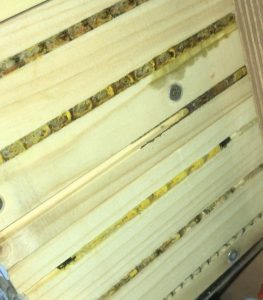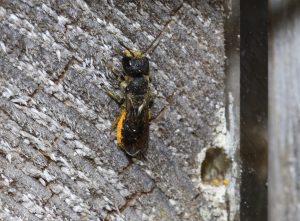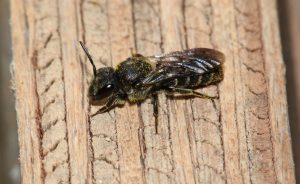Heriades truncorum The Large-headed Resin Bee
An interesting new addition to the bees using a Nurturing Nature observation nest box was recently found and photographed by Dr Hauke Koch at Kew Gardens. This time it is Stelis breviuscula a cleptoparasite of Heriades truncorum. For those of you who have a Nurturing Nature solitary observation nest box popular summer unit and have the resin bee Heriades truncorum using it to nest inside, keep a lookout for this new species using the nest box. The Large-headed resin bee also uses for its nest sites, old burrows made by beetles exiting in sound wood, as well as cavities in brickwork, rubus stems and according to Else and Edwards, in decaying wooden window frames.

Heriades truncorum, with dead female near the rear end in Nurturing Nature Nest box
Else and Edwards of BWARS describes it as ” A small elongate bee with distinctive terminal white hair bands on the abdomen; the female with an orange scopa. This species has always been considered scarce and associated with the commons of Surrey. It utilises resin in the making of the partitions of its nest and the assumption that this could only be provided by pines, combined with its apparent restriction to heaths, suggested to some that it must be an introduction to Britain. I was therefore pleasantly surprised when G R Else found a large population-based at Thorney Island, with not a pine in sight! Not only this, but this population also had the specialist cleptoparasite Stelis breviuscula present. This latter bee had only been recently discovered in Britain at Iping Common by G R Else a year or two earlier. This story reveals the perils of believing that everything is already known about any particular species – West Sussex had been hardly visited by aculeate hymenopterous in the hundred years previous to G R Else and me taking an interest in the western section of the county”.

Heriades truncorum outside its Nurturing Nature nest at Kew Gardens
Stelis breviuscula – Little Dark Bee
This bee, according to BWARS was first found at West Sussex in 1984. Looking at the BWARS distribution map, it is found clustered around the south-east. “The very few British records of this small bee are from a handful of sites in West Sussex (particularly the Midhurst and Emsworth areas) and two in Surrey. British records and observations are summarised by Else (1998). The bee may also occur in other localities in southern England which support its host species, the bee Heriades truncorum.

Stelis breviuscula waiting outside its host’s nest which was inside a Nurturing Nature nest box
Can be found in clusters
According to Else and Edwards, this bee, unlike other species of Stelis, can be found in numbers around the nest sites of its host, citing up to around 30 individuals observed in the morning on fence posts used by their host.
Flowers
Falk states that it typically visits yellow composites such as ragworts, hawkweed and common fleabane, as does its host. So to see this small cuckoo bee you need its host, the resin bee, Heriades truncorum, yellow composite flowers and somewhere for the host bee to live. Falk suggests that the best way to view this bee is to observe them flying, resting or visiting flowers close to the host nesting areas. Dr Hauke Koch saw this small bee enter the nesting cavity of its host and like all cuckoos bees, it just nips in, lays its egg and sharply exits. I have myself witnessed this behaviour several times with Coelioxys bees and I was fortunate to enough to film with the resulting larva still inside the host’s leafcutter cell. Probably something many people have not seen themselves. Both S. breviusula and Coelioxys bees are cleptoparasites of other bees and do not make a nest or forage for provisions. One thing that amazes me is that I have seen many cleptoparsites waiting outside a host’s nest and the host never chases them away. The only times I have seen such action is when the host is still inside her cavity and she attacks the intruder there and then when the invader enters. No wonder the cleptoparaites make a sharp exit! Even when no host is present. Must be in their genes!
Refs.
Besides my own observations:
For more information about solitary bees see BWARS
Handbook of the Bees of the British Isles, Else and Edwards
For info and link to buy an excellent book Field Guide to the Bees of Great Britain and Ireland by Steven Falk
An extremely useful resource supports this book by a special website feature within Steve Falk’s Flickr website which furnishes extra photos and other useful resources to assist with identification
Solitary Bees book by Ted Benton
Interested in Citizen Science and pollinators? (e.g. bees!) The Buzz Club
With many thanks to Dr Hauke Koch for his photographs at Kew Gardens

Hi George,
We’ve had a large number of H. Truncorum making nests in hollow bamboo our newly built bee home this year. Hopefully plenty are viable and stay okay over winter, but I want to dissaude them from using the same tubes next year. I was thinking to split the bamboo once they’re hatched and let the pheromones draw them to newly prepared tubes. But 1) is there a way to tell when all the cells are hatched, and 2) can you think of a way to let the new bees out without letting new ones in? I was thinking of hanging a loose piece of paper in front on the tubes that they could hopefully push out the way when emerging, whilst still keeping the exit light enough to draw them out. I note that all these problems would be sovled with one of your nest boxes(!), but wondered if you’d any idea in the meantime?
Cheers, Tom
Tom, that sounds like you have some sensible ideas to test out, so try them. I stopped using bamboo etc., year ago and only use my own nest boxes, so no need to do things like that anymore! Thanks For sharing. George